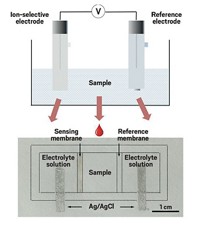Advertisement
Grab your lab coat. Let's get started
Welcome!
Welcome!
Create an account below to get 6 C&EN articles per month, receive newsletters and more - all free.
It seems this is your first time logging in online. Please enter the following information to continue.
As an ACS member you automatically get access to this site. All we need is few more details to create your reading experience.
Not you? Sign in with a different account.
Not you? Sign in with a different account.
ERROR 1
ERROR 1
ERROR 2
ERROR 2
ERROR 2
ERROR 2
ERROR 2
Password and Confirm password must match.
If you have an ACS member number, please enter it here so we can link this account to your membership. (optional)
ERROR 2
ACS values your privacy. By submitting your information, you are gaining access to C&EN and subscribing to our weekly newsletter. We use the information you provide to make your reading experience better, and we will never sell your data to third party members.
Analytical Chemistry
Paper microfluidics device enhances cancer biomarker detection
Nanostructured channels help wick samples faster and amplify fluorescent signals
by Melissae Fellet
May 9, 2016

Creating highly ordered channels in a paper microfluidic chip improves fluid flow and enhances fluorescence signals in biomarker detection (Anal. Chem. 2016 DOI: 10.1021/acs.analchem.6b00802).

Paper microfluidic devices are cheap and easy to produce, so they can be used for inexpensive medical diagnostic tests. To make a paper chip, researchers print a hydrophobic ink or wax on chromatography or filter paper, leaving channels of the paper exposed. Fluids placed at the end of a channel wick through the paper, traveling to areas of the chip prepared for detection. For example, the areas can be preloaded with antibodies that capture proteins, like cancer biomarkers, in a sample. But the random arrangement of cellulose fibers in the channel makes the flow rate uneven, which impacts the reproducibility of the tests.
Hong Liu, Zhongze Gu, and colleagues at Southeast University wanted to improve the performance of paper microfluidics by giving the channels a highly ordered nanostructure. The researchers decided to do this by forming nanosized fibers of cellulose around an array of silica nanoparticles used as a template.
The researchers first printed hydrophobic toner on a polypropylene substrate to outline an area for the channels. Then they dropped a suspension of silica nanoparticles onto the unprinted areas and used a rubber blade to evenly distribute the liquid. After the solution dried, the nanoparticles self-assembled into an array. Then the researchers dropped a solution of nanocellulose onto the particles, and the nanocellulose fibers surrounded them, forming a similar pattern. Finally, the researchers removed the nanoparticles by acid etching, leaving a porous crystal of nanocellulose.
A chip made with nanostructured channels had a wicking rate twenty times as fast as one made using commercially available nanocelluose. The researchers could control the wicking rate of fluid through the nanocellulose by changing the size of silica nanoparticles used to make the template.
What’s more, the nanocellulose channels formed a photonic crystal, an ordered structure that can reflect, confine, or transport light, giving the paper device enhanced optical properties. The researchers built a paper chip using 320-nm-diameter silica nanoparticles to detect two cancer biomarkers using fluorescence detection. When they introduced a sample containing both biomarkers into the device, they found that the fluorescence signal was 80 times as strong for the nanocellulose channel as for a nonporous nanocellulose membrane.
Making paper devices sensitive and easy to read is a challenge, and this photonics structure is a significant step towards achieving those things, says Charles S. Henry of Colorado State University. He wonders if this strategy could be used for tests involving small molecules or other biomolecules like nucleic acids or enzymes.
Liu says nucleic acids could indeed be placed in the detection areas of a chip like this one.
Edith Chow of Australia’s Commonwealth Scientific & Industrial Research Organisation, says the most costly aspect of this test is the fluorescence microscope used to measure the light emitted from the chip, but the cost per test could be reduced by not using fluorescent labels for detection.





Join the conversation
Contact the reporter
Submit a Letter to the Editor for publication
Engage with us on Twitter